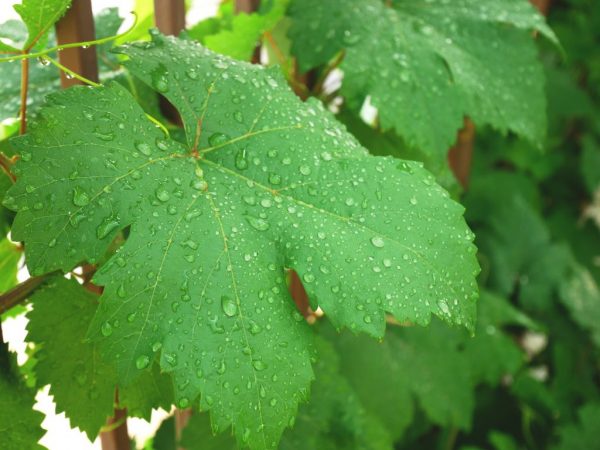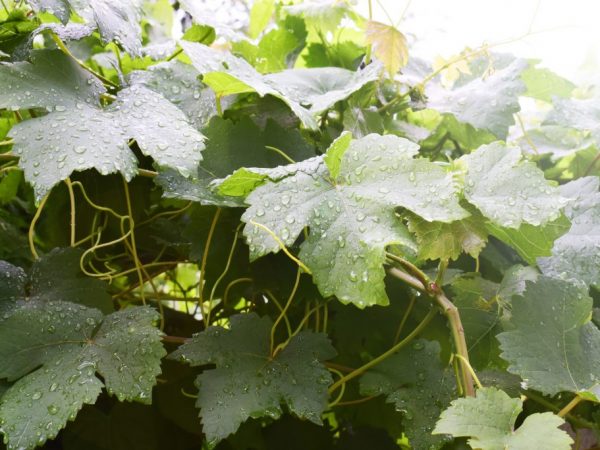Features of feeding grape bushes
Plants on a plot of land tend to deplete the soil on which they grow. To get a good harvest, it is necessary to add nutrients to the soil in order to replenish their supply. Fertilizing grapes before and after flowering plays an important role.

Features of feeding grape bushes
Why feed grapes
Adding a sufficient amount of fertilizer to the soil when planting a vine ensures its active growth in the first 3-4 years. Young plants especially need regular feeding. An excess of the required amount of nutrients negatively affects the general condition of the plant: the bush accumulates trace elements in the branches and shoots in order to grow a dense crown, and postpones the fruiting period until more "hungry" times.
The lack of minerals makes the plant weaken, increases its susceptibility to diseases and infections, destroys the natural protective barrier against pests.
Features of feeding an adult fruiting bush depend on the environmental conditions where it germinates, climatic conditions, soil composition, grape varieties. In this case, the vine requires regular and timely feeding, closely related to the vegetative periods of the plant's life, season and age.
Feeding stages
Fertilize grapes during periods of active growth and development of the bushes.
Stage 1
The first stage (early May – mid May) is carried out 7-10 days before flowering. During this period, the vine spends a lot of energy and effort to form inflorescences, using all the reserves of minerals. For this, various mineral organic fertilizers are used.
There are several recipes that use combinations:
- 8 g of potassium magnesia and 15 g of ammonium nitrate per bucket of water;
- 2 kg of rotted manure per 10 liters of water;
- 50 g of nitrophoska and 0.4 g of boric acid per bucket of water.
All these solutions are designed for 1 sq. m area. Before adding fertilizer to the bush, the ground is loosened to a depth of at least 25 cm and the root system is protected with a roller from the ground so that the solution does not spread.
Stage 2
The second stage (mid to late July) takes place 10-16 days after the end of flowering. The same fertilizers are introduced into the soil as in the first stage. They help the formation of fruit mass, improve the condition of leaves and shoots. After a week, watering is repeated.
Stage 3
The third stage begins 14 days before the fruit ripens. At this time, conditions are created to increase the size of the fruit and increase the sugar content in them. For this, nitrogen components are removed from use. Complex irrigation is carried out with fertilizers from 20 g of superphosphate and 20 g of potassium salts per bucket of water, 1 kg of manure per 10 liters of water per 1 sq. m.
Stage 4
The fourth stage occurs at the time of ripening of the berries in order to strengthen the bush. To do this, the root system is fertilized with 2 diluted micronutrient tablets in a bucket of water.
Stage 5
The fifth stage - the last one - is carried out after harvest to maintain resistance to diseases and infections, as well as to prepare the vines for wintering. The fertilizer contains 1 tbsp. l. potassium magnesium diluted in 10 liters of water.
Fertilizers

Fertilizing Helps Increase Yields
Minerals and trace elements are used in combination to provide good yields and comprehensive plant support in the period before and after flowering. By combining the components, a universal fertilizer is obtained. The beneficial substances that grapes need include the following:
- The copper used in the Bordeaux mixture increases the activity of the plant during growth, and also helps build strength for resistance to frost and drought.
- Phosphorus is necessary at the beginning of flowering, because it helps to form inflorescences, ovaries. Superphosphate speeds up the metabolic process in the branches, therefore it is useful during the ripening of bunches.
- Zinc increases productivity due to its ability to timely and efficiently control fertilization processes.
- Nitrogen is present in substances such as urea or carbamide, ammonium sulfate, ammonium nitrate. It has a positive effect on the development and growth of green mass of leaves and shoots. This fertilizer is applied at the beginning of spring, before the period of active growing season; in the summer it is contraindicated to carry out such an action.
- Boron - boric acid - an element that is responsible for the accumulation of sugar in fruits and accelerates the ripening of berries. It is able to move sugary compounds and carbohydrates. Characterized by a positive effect on pollen formation, it is often used for fruit formation.
- Potassium is represented by such a substance as potassium chloride, as well as ash, which contains phosphorus compounds. This element accelerates the process of fruit ripening, concentrates the necessary forces for the survival of the vine during periods of sharp temperature changes: in severe frosts or drought. Potassium regulates the quality of intracellular juice, reduces moisture loss, which helps the plant to receive all the necessary elements and substances.
Foliar dressing
This type of feeding is used when feeding under the root of the plant does not give the expected results. Foliar dressing is carried out by spraying leaves, shoots and bunches. To get a positive result, they determine what substances are missing in the grapes, at what time of day to carry out the action, in what period of the growing season it is worth doing something.
First foliar feeding
The first foliar dressing is carried out 7 days before the beginning of the flowering of the grapes. It helps to reduce shedding of flowers and increase the number of ovaries.
Foliar dressing is combined with spraying the bushes with fungicides. The green mass is fertilized on cloudy days in the morning or in the evening so that the compounds that fall on the leaves are not burned under the influence of sunlight. For this feeding, use a mixture:
- 0.2% ammonium sulfate;
- 0.6% potassium sulfate;
- 0.5% urea;
- 0.05% manganese;
- 0.03% zinc;
- 10 liters of water;
- 30 g of glycerin or vegetable oil.
Second foliar feeding
The second spraying of the bush is used, if the plant needs it, to improve fruiting and the formation of bunches, to strengthen the shoots. For her, the same components are used as for the first feeding.
Sometimes the second feeding is limited, sometimes there are several of them. In the second half of summer, it is better to refrain from this action, because the acceleration of the growth of young shoots during this period weakens the grapes before wintering, as a result, the branches will destroy the first frost.
Root dressing
Root dressing is carried out after the flowering of the vine.
Top dressing of grapes before flowering is carried out in the same way. When preparing, they dig holes up to 40 cm deep or in the form of a continuous trench at a distance of half a meter from the stem of the bush. Sometimes pipes are buried in such depressions to ensure that substances enter the root system.A fertilizer solution is poured into the pits or through pipes, followed by a large amount of water, in this way combining top dressing and watering. Such a system allows the roots to quickly and efficiently absorb the necessary micro and macro elements, distribute them to the branches.
To prepare a mixture for root feeding, the following components are used:
- chemical fertilizers: superphosphate, fungicide, ammonium nitrate, boric acid, phosphoric, ammonium, potassium fertilizers;
- organic matter: chicken manure, manure, ash, compost.
Conclusion
Fertilizing grape bushes in the period before and after flowering gives a positive result when the process takes into account all the conditions for the growth of the plant, as well as its variety and needs.
The use of an integrated approach, when foliar and root dressing are combined, gives the best possible result, allowing you to get a rich harvest and provide the vine with a comfortable existence at any time of the year.


